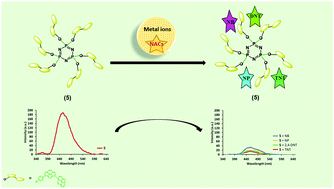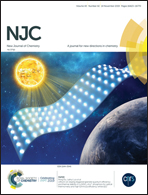Constitutional isomers of dendrimer-like pyrene substituted cyclotriphosphazenes: synthesis, theoretical calculations, and use as fluorescence receptors for the detection of explosive nitroaromatics†
Abstract
Two constitutionally isomeric bis-pyrenyl phenol dendrons (4 and 6) and their dendrimer-like cyclotriphosphazene derivatives (5 and 7) with different architectural motifs on the periphery of the cyclotriphosphazene ring are designed and synthesized, and their structural characterization is carried out using standard spectroscopic techniques (elemental analysis, 1H, 31P and 13C NMR spectroscopies and MALDI-TOF mass spectrometry). The thermal and photophysical properties of these newly synthesized compounds are also investigated. The geometric optimization of the constitutional isomeric dendrons and their dendrimer-like derivatives, HOMO–LUMO energy levels and molecular interactions are performed using density functional theory calculations at the wB97XD/6-31G(d) level. The fluorescence detection behaviors of 5 and 7 are evaluated for nitro aromatic compounds (NACs). Results of measurements show that explosive nitroaromatics efficiently quenched fluorescence emission, whereas other tested competitive species (toluene, RDX, picric acid, benzene and 20 metal ions) induced no spectral changes, suggesting that these dendrimer-like cyclotriphosphazene derivatives (5 and 7) could be promising candidates to be applied as sensors for explosive nitro aromatics with high selectivity and sensitivity.



 Please wait while we load your content...
Please wait while we load your content...